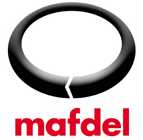Our mono-material conveyor belts can be repaired on site in case of damage by using a hot air welding repair.
If there is a cut:
– Make a 45° bevel on both sides of the cut
– Using a hot air welding gun, fill the bevelled cut with a melted plastic seam that is of the same quality as the belt
– Use a cutter to level down the excess material.
In cases where the belt has a heavily damaged area, it is possible to replace an entire section. Our thermowelding jointing techniques allow for this operation to be carried out very quickly on site.






